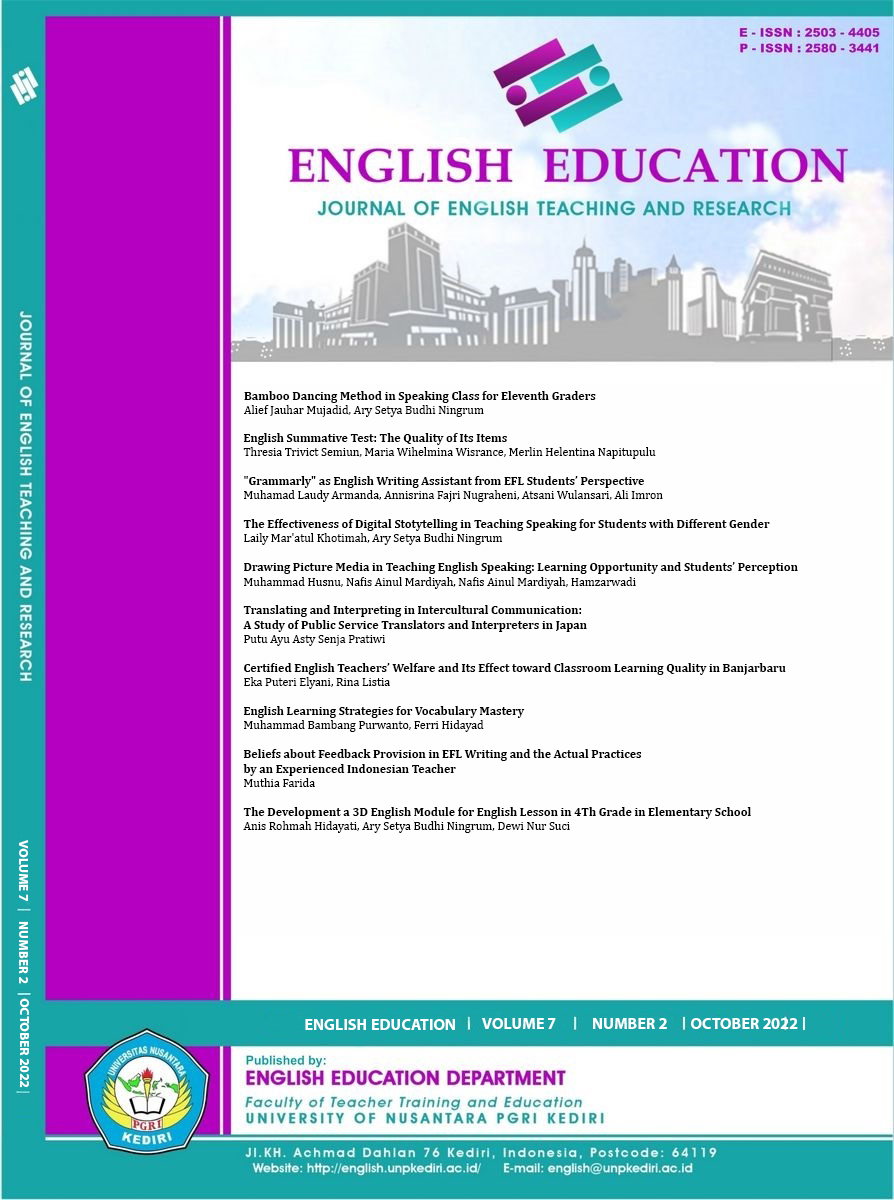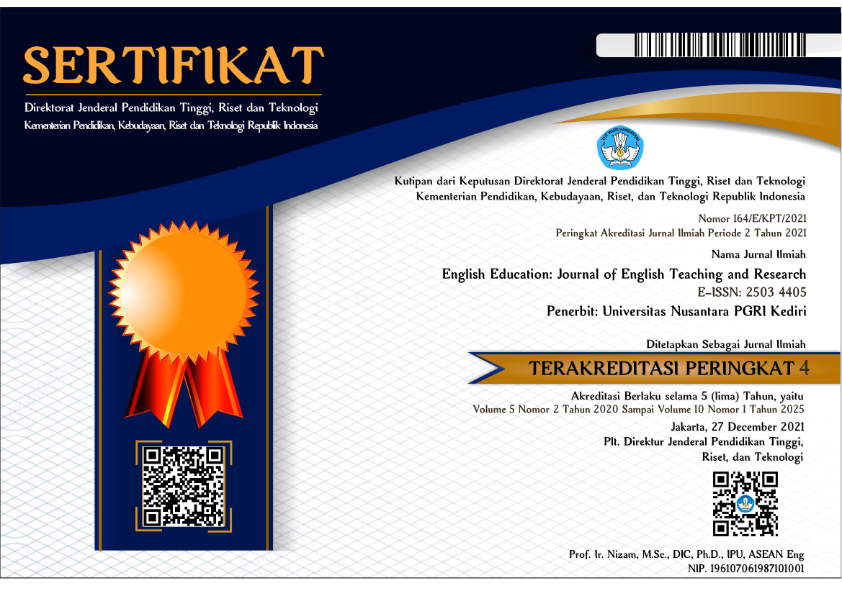Bamboo Dancing Method in Speaking Class for Eleventh Graders
DOI:
https://doi.org/10.29407/jetar.v7i2.18082Keywords:
bamboo dancing method, speaking skillsAbstract
The goal of this study is to see how effective the Bamboo Dancing Method is for teaching speaking skills. This study is quasi-experimental in which students in class XI SMAN 2 Pare were the focuses of this investigation. Class XI MIA 1 was the experimental group, and class XI MIA 7 was the control group. Pre-test and post-test in the form of speaking tests are employed for collecting data. In analyzing the data, ANCOVA was used to calculate the results. In the pre-test findings, the average value of the experiment was 53.00, while the control group mean was 54.00. The average value for the experiment on the post-test was 77.00, while the mean score for the control group was 73.83. According to the statistical calculation findings of ANCOVA, the results were significantly high, .000 < .05. Since the significance value is less than 0.05, it suggests that there is sufficient evidence to reject the null hypothesis; hence the alternative hypothesis is accepted. This indicates that employing the Bamboo Dancing Method to develop speaking skills is efficient.
Downloads
References
Agustina, S., Syaprizal, & Yulfi. (2021). Teaching Speaking Skill By Using Bamboo Dancing Method. Journal of English Teaching, Applied Linguistics and Literature (JETALL), 4 (1), 11-17.
Aryanti, P., Gani, S.A., and Achmad, D. (2021). The Effectiveness Of Bamboo Dancing Technique To Improve Students Speaking Skill. Research in English and Education (READ), 6 (1), 23-29.
Batang, N.T. (2016). Teaching Speaking Of Englis As A Foreign Language: Problems and Solutions. EDUCATION, TOURISM AND LOCAL WISDOM ISSUES Vol. 2 No. 1.
Chapelle, C.A., Jamieson, J., & Hegelheimer. (2003). Validation of a web-based ESL test. https://doi.org/10.1191%2F0265532203lt266oa
Fraenkel, J. R., Wallen, N. E., & Hyun, H. H. (2012). How to Design and Evaluate Research in Education. New York: The McGraw-Hill Companies.
Gita, Y. S & Ismiyati, Y. (2021). The Effect of Using Bamboo Dancing Cooperative Learning Strategy Towards Student English Speaking Skill in Senior High School 3 Jambi City. Journal of English Language Teaching, 5 (1), 50-58.
Guzmán, V. E. (2020). Characteristics and Skills of Leadership in the Context of Industry 4.0. Procedia Manufacturing, 43, 544.
Hadi, M. S., Mutiarani, & Sari, M.I. (2021). The TED Talks as a Learning Tool in Teaching Speaking. English Education: Journal of English Teaching and Research, 6 (1), 45-52.
Hakim, M. I. A. A. (2019). The Use of video in Teaching English Speaking. Research Methodology in Linguistics and Education, 4 (2), 362.
Harianto dan Dalle, A. (2018). Keefektifan Model Pembelajaran Kooperatif Tipe Bamboo Dancing dalam Keterampilan Berbicara Bahasa Jerman Siswa Kelas XI IPA SMA Negeri 7 Bulukumba. Eralingua: Jurnal Pendidikan Bahasa Asing dan Sastra, 2 (1), 9-14.
Haris, D. P. (1969). Testing English As A Second Language. New York: McGraw-Hill Book Company.
Huda, M. (2011). Cooperative Learning: Metode, Teknik, Struktur dan Model Terapan. Jogyakarta: Pustaka Belajar.
Hurlock, E.B. (2019). Psikologi Perkembangan. Jakarta: Erlangga.
Isnaeni, E.R.N & Nurdiawati, D. (2017). The Effectiveness of using Bamboo Dancing Method to Improve the Students’ Speaking Skill in Recount Text. Dialektika Journal, 5(1), 34-36.
Mahmudah, E. (2020). The Use of Bamboo Dancing Technique to Improve Students’ Speaking Skill. Journal of Education, Language, Literature, Arts and Culture. Vol 5 No 1
Mandasari, B. & Aminatun, D. (2020). Improving Students’ Speaking Performance Through Vlog. English Education: Journal of English Teaching and Research, 5 (2), 136-142.
Maulidah, I. (2017). Vlog: The Mean to Improve Students’ Speaking Ability. Proceedings of The International Conference on English Language Teaching (ICONELT), 12-15. DOI: https://doi.org/10.2991/iconelt-17.2018.3.
Nakamura, S., Darasawang, P., & Reinders, H. (2021). The antecedents of boredom in L2 classroom learning. System, Volume 98.
Putri, C. R., Usman, B., & Chairina. (2016). Board Game in Speaking Skill. Research in English and Education (READ), 1 (2), 146-151.
Roever, C and Phakiti, A. (2018). Quantitative Methodes For Second Language Research. Routledge.
Rukminiwati. (2018). Improving Learning Activities and Speaking Skills of Class I Students in Indonesian Language Learning using Bamboo Dancing method at SD N 04 Pasa Gadang Padang. Journal Fakultas Keguruan dan Ilmu Pendidikan Beranda, Vol 8 No 3. Page 2 - 4
Setiawan, U.D., Suharjito, B, & Putra, B.A.W. (2021). The Use of Bamboo Dancing Technique to Improve the Eleventh Grade Students’ Speaking Achievement. EFL Education Journal, 8 (3), 46-51.
Siahaan, M. (2018). The Effect Of Bamboo Dancing Learning Model on students’ Speaking Ability (A Study at The Eleventh Grade Students of SMK Negeri 1 Sarudik 2017/2018 Academic Year). Jurnal Liner, 1(3), 29-37.
Syakur, M.A. (2020). The Use of Board Game in teaching Speaking to Young Learners). English Education: Journal of English Teaching and Research, 5 (2), 149-155.
Ubaedy, A.N. (2018). Interpersonal Skill: Bagaimana Anda Membangun, Mempertahankan, dan Mengatasi Konflik Hubungan. Jakarta: Bee Media Pustaka.
Wahyuni, N.E.L. (2015). The Use of bamboo Dancing Technique to Improve the Seventh Grade Students’ Speaking Ability in Interpersonal Conversation. ELT Forum: Journal of English Langauge Teaching, 4(1). Page 2
Waryadi, Kadir, & Rahayu W. (2019). Effect of Bamboo dancing Learning Model and Early Ability Against Habit of Mind Mathematical Students. Journal Of Development Research, 3 (2), 52-59.
Zumam, W. & Fujiono. (2020). Using English Movie to Enhance Students’s Interest in Speaking Skill at SMAN 1 Galis Pamekasan. English Education: Journal of English Teaching and Research, 5 (1), 62-73.
Downloads
Published
Issue
Section
License
Authors who publish with this journal agree to the following terms:
- Copyright on any article is retained by the author(s).
- The author grants the journal, the right of first publication with the work simultaneously licensed under a Creative Commons Attribution License that allows others to share the work with an acknowledgment of the work’s authorship and initial publication in this journal.
- Authors are able to enter into separate, additional contractual arrangements for the non-exclusive distribution of the journal’s published version of the work (e.g., post it to an institutional repository or publish it in a book), with an acknowledgment of its initial publication in this journal.
- Authors are permitted and encouraged to post their work online (e.g., in institutional repositories or on their website) prior to and during the submission process, as it can lead to productive exchanges, as well as earlier and greater citation of published work.
- The article and any associated published material is distributed under the Creative Commons Attribution-ShareAlike 4.0 International License








 Article template
Article template



